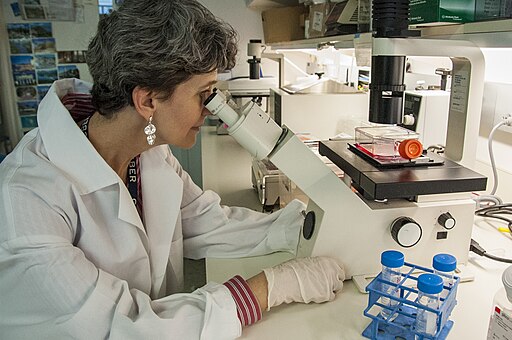
Scientist looking at pig cells
Imagine waiting for a phone call that could save your life, but you never get the call. This is a reality for many patients that are on an organ transplant list. Recently scientists have found a way to make it possible for a patient to get a transplant without waiting for the rest of their lives. Richard Slayman is a 62 year old man from Massachusetts who, went through xenotransplantation, received the first pig kidney transplant while still alive. How would you feel about receiving an organ from a pig?
In recent years scientists have been genetically engineering pigs for human organs to address the lack of human organs available for transplant surgeries. Many of past transplants have been unsuccessful. Some of the transplants included “hooking a kidney up to a brain-dead organ donor’s body, and another involved performing a double-kidney transplant in a brain-dead patient. In addition, in 2022, a man underwent the first pig-heart transplant but died shortly thereafter”
Richard Slayman faced type 2 diabetes and high blood pressure which lead him to seven years of dialysis before his first human kidney transplant in 2018. This transplanted organ began to fail five years later which pushed him back to dialysis in 2023. This lead Richard to receiving the kidney transplant. The wait for another human transplant would have been too long. Richard was presented with an opportunity to get a transplant using a kidney from a genetically engineered pig. What would you do wait or get the transplant? The genetically engineered pig was developed by eGenesis using CRISPR technology. The total number of gene edits in the DNA was 69.

Doctors performing an organ transplant
The scientists removed three genes responsible for creating carbohydrates that trigger human immune responses. They also added seven human genes to prevent potential immune system rejections, and they deactivated certain viral DNA sequences known as endogenous retroviruses that could pose risks to human health. These adjustments were done to ensure the organs are safe for transplantation into the human body.
Richard Slaymans pig transplant has been a huge success. So are pigs going to lead the way in organ transplants? So far it seems to be the case. Richard Slayman in the past few days has left the hospital. Now the doctors need to continue to check in with Richard to make sure all is going well. This is very important because it is common for the transplanted organ to be rejected and also possible infection. To prevent this the doctors have to give the patient a perfect balance of immunosuppressive drugs. “too low a dose can lead to rejection, while too much can make a patient vulnerable to infection”
In AP Bio we learn about the importance of DNA and RNA function and the manipulation of it. DNA determines the production of RNA, and the RNA then allows for the production of proteins that carry out all the functions we need it to. CRISPR technology uses guide RNA, which is specifically made to match particular DNA sequences. This allows CRISPR to harness a cell’s mechanisms to precisely target and alter genetic data. This process demonstrates roles of DNA and RNA in genetic expression and regulation, and being able to do this will allow for a lot more possibilities. This topic also relates through the impact of the immune system when the organ transplant happens. The immune system plays a role in distinguishing between self and non-self cells. When a foreign organ is transplanted, the recipient’s immune system may recognize it as a threat. This leads to organ rejection. This immune response is lead by T cells that identify mismatched human leukocyte antigens on the donor organ. To prevent rejection, patients will undergo immunosuppressive therapy, which will lower the immune system’s activity but this also increases susceptibility to infections and other diseases. What do you think about the process of organ transplants. Is it efficient the way it is or will new science make it more efficient with the help of animal organs?





Leave a Reply